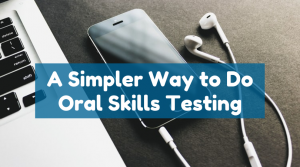

Blended and online language courses are an increasingly common occurrence in colleges and high schools across the country. They allow students who, for many different reasons, cannot physically come to class three times a week to either start or continue learning a language; at the program level, pooling together students from multiple schools makes it possible to offer upper-level courses or languages not traditionally offered at the home institution.
Online language courses present many benefits. However, they also trigger a great deal of resistance and skepticism, which crystallizes around the question of oral proficiency. Is it possible to help students develop oral proficiency in fully online courses?
In the first week of the certificate course dedicated to online and blended instruction, we leverage existing research as well as our personal experience and beliefs as language educators to explore this question.
Evaluating the online language classroom
An important first step is to realize that the F2F classroom should not be the measuring stick by which we assess the effectiveness of an online language course. By trying to port our F2F practices online, we might miss on unique affordances of the online modality. After all, people have been learning languages for thousands of years, without technology, but also without classrooms. The classroom as a formal place of learning is only about a hundred and fifty years old, and a relatively new player in the history of human learning. Many language learning activities play to the unique strengths of the physical classroom but might not work as well online. It is, therefore, a better approach to think in terms of learning objectives and search for ways to realize them effectively when teaching fully online. We might in the process find even better ways to help students develop high levels of oral proficiency.
Let’s discuss the unique affordances of blended and online language learning.
Opportunities for differentiation
Compared to other subjects, the language classroom is particularly performance-oriented, which can be an intimidating proposition for the shy student or for students who suffer from various forms of social anxiety. Also, students with learning differences, especially students who need more time to process the material, will benefit from being able to view a lesson or listen to a recording multiple times. In sum, having the option to take an online course might compel students to consider learning a language after all.
Scaffolding of live/synchronous speaking events
Thanks to the many recording tools available online (Extempore, FlipGrid, VoiceThread, Adobe Spark, etc), students have the opportunity to record and listen to themselves as many times as they wish. This is a departure from the spontaneous nature of in-class activities and should not be the only type of oral practice they engage in. However, asynchronous exercises are an excellent way to scaffold and/or follow -up on spontaneous speaking events. Besides, listening to themselves, something students probably rarely do, and writing short reflections is a valuable language learning exercise. Online recordings may also allow students to track their progress over time, which can be quite encouraging for students and teachers alike.
Synchronous speaking
So what about real-time communication? There are many tools teachers can use to foster interpersonal exchanges in the online language classroom: video conferencing tools such as Zoom, GoogleHangout or Skype provide user-friendly solutions for live sessions. Many of these tools offer breakout rooms for small group work.
Another interesting aspect of the online classroom is that it offers opportunities to bring outside voices in the form of virtual guest speakers or even, one-to-one conversations. In the F2F classroom, the teacher tends to be the primary source of input and with ever-increasing class sizes, students don’t always get a much speaking practice as they need. The online classroom is a good opportunity to increase speaking time but adding a telecollaboration element to the curriculum. Services such as Talkabroad or Boomalang offer sessions with trained and vetted language partners via video conference. The service they offer includes scheduling, recording of the sessions and teacher dashboards to upload assignments and follow up on student progress. For schools with limited budgets, there are also free options such as the Mixxer that offer to pair students one-on-one or even, entire classes. With adequate preparation, these activities can drastically boost students' interpersonal communication skills, intercultural competence and overall motivation to pursue their language study.
As we conclude the blended and online language course, many teachers comment that what they have learned about online language instruction had a significant impact on their F2F teaching practices. Interestingly, exploring language learning outside of the classroom context might set us up on a path to re-imagining language instruction altogether.
Want to Keep Reading?
We have a lot of content on our blog, if you haven't seen our post on simplifying oral skills testing- give it a read!

This post is courtesy of Edwige Simon, PhD who is the Faculty Director of the Graduate Certificate in Language Teaching with Technology at the University of Colorado Boulder. She has been working in the field of education for fifteen years. Her research interests focus on professional development and language technology. She served as the 2013-2015 Programs Director of the International Association for Language Learning Technology, and she is the founding editor of the FLTMAG, a free magazine dedicated to technology integration in the world language classroom.


